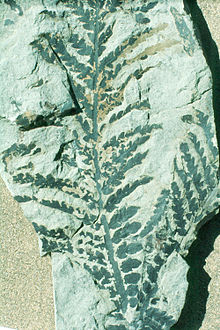Dicroidiumis an extinct genus of fork-leavedseed plants.It is the archetypal genus of thecorystosperms,an extinct group of seed plants, often called "seed ferns",assigned to the order Corystospermales or Umkomasiales. Species ofDicroidiumwere widely distributed and dominant overGondwanaduring theTriassic(252 to 201million years ago). Their fossils are known fromSouth Africa,theArabian Peninsula,Australia,New Zealand,South America,Madagascar,theIndian subcontinentandAntarctica.
| Dicroidium Temporal range:
| |
|---|---|

| |
| Leaf impression ofDicroidium zuberi | |
| Scientific classification | |
| Kingdom: | Plantae |
| Clade: | Tracheophytes |
| Order: | †Corystospermales |
| Family: | †Corystospermaceae |
| Genus: | †Dicroidium Gothan (1912) |
| Species | |
| |
| Synonyms | |
| |
Description
editWithin the form genus classification system used in paleobotany, the genusDicroidiumrefers specifically to the leaves. Some authors have suggested dividingDicroidiumup into several genera, includingDicroidiopsis, Diplasiophyllum, Zuberia,Xylopteris,JohnstoniaandTetraptilon,but this is rejected by other authors.[4]The leaves ofDicroidiumbifurcate (fork) at their base, which is characteristic of all species. The leaves are highly variable in size and morphology, ranging from simple totripinnate,with the individualleafletshaving varying morphologies, includingdissected,lobed,needle-like andentire.[5]Some leaf specimens have more than one type of leaflet morphology, which may have been the result of hybridisation between different species.[4]Thevenationof the leaves is also highly variable, encompassing taeniopteroid, odontopteroid, alethopteroid and simple morphologies.[5]
Whole plant
editDicroidiumplants grew as medium-large sized trees,[5]with some preserved trunk sections 10 metres (33 ft) tall and over 50 centimetres (20 in) wide,[4]with the wood assigned to the generaKykloxylonandRhexoxylon.Theovulatereproductive structures are usually assigned to the genusUmkomasia,while the pollen-producing organs are assigned to the genusPteruchus,with pollen attributable to the genusFalcisporites.These structures are almost never found in organic connection, and their placement as part of the same plant primarily relies on their repeated co-occurrence with each other, and the similarities in the morphology of theircuticles.[6]The leaves grew on short protuberances attached to the stem in a similar way to livingGinkgo biloba.[7][8]The leaves ofDicroidiumare suggested to have beendeciduous,and shed along with the reproductive organs during the winter. The seeds and pollen are suggested to have beenwind dispersed.[4]
Possible whole plant associations include:
- Dicroidium odontopteroidesmay have been produced by the same plant asUmkomasia macleanii(ovulate structures) andPteruchus africanus(pollen organs).[9]
- Dicroidium zuberimay have been produced by the same plant asUmkomasia feistmantelii(ovulate structures) andPteruchus barrealensis(pollen organs)[10]
Evolution
editThe earliestDicroidiumspecies are known from theLate PermianagedUmm Irna FormationofJordan,which inhabited equatorial humid tropical environments,[6]as well as equivalently aged more southerly subtropical deposits on the Indian subcontinent.[11]Following theend-Permian mass extinction,Dicroidiumexpanded its range southwards acrossGondwana,including South Africa, Antarctica, Australia, New Zealand and South America,[6]with a record also reported from the Middle Triassic of China.[12]Later TriassicDicroidium-bearing plants were dominant largecanopyforming trees in temperate wetland and forested habitats at mid-high latitudes, extending to the South Pole.[4][5][6]Dicroidium-dominanted ecosystems in Gondwana collapsed during theend-Triassic mass extinction,withDicroidiumsurviving in parts of East Antarctica into the Early Jurassic (Sinemurian).[5]
References
edit- ^THE TRIASSIC TAPHOFLORA FROM PARANA BASIN, SOUTHERN BRAZIL
- ^Retallack G.J. (1985)."Triassic fossil plant fragments from marine rocks of the Murihiku Supergroup, New Zealand".Journal of the Royal Society of New Zealand.15:1–26.doi:10.1080/03036758.1985.10421741.
- ^Passo das Tropas, Santa Maria, RS Marco bioestratigráfico triássico na evolução paleoflorística do Gondwana na Bacia do Paraná.
- ^abcdeMays, Chris; McLoughlin, Stephen (2020-02-25)."Caught between two mass extinctions: The rise and fall of Dicroidium".Deposits Mag.Retrieved2023-09-23.
- ^abcdeBomfleur, Benjamin; Blomenkemper, Patrick; Kerp, Hans; McLoughlin, Stephen (2018),"Polar Regions of the Mesozoic–Paleogene Greenhouse World as Refugia for Relict Plant Groups",Transformative Paleobotany,Elsevier, pp. 593–611,doi:10.1016/b978-0-12-813012-4.00024-3,ISBN978-0-12-813012-4,retrieved2020-11-12
- ^abcdBlomenkemper, Patrick; Kerp, Hans; Abu Hamad, Abdalla; Bomfleur, Benjamin (July 2020)."Contributions towards whole-plant reconstructions of Dicroidium plants (Umkomasiaceae) from the Permian of Jordan".Review of Palaeobotany and Palynology.278:104210.doi:10.1016/j.revpalbo.2020.104210.
- ^Anderson, H.M., Holmes, W.B.K. & Fitness, F.A., 2008.Stems with attachedDicroidiumleaves from the Ipswich Coal Measures, Queensland, Australia.Memoirs of the Queensland Museum52,1–12.
- ^Anderson, Heidi M.; Barbacka, Maria; Bamford, Marion K.; Holmes, W. B. Keith; Anderson, John M. (2020-01-02)."Dicroidium (foliage) and affiliated wood Part 3 of a reassessment of Gondwana Triassic plant genera and a reclassification of some previously attributed".Alcheringa: An Australasian Journal of Palaeontology.44(1): 64–92.doi:10.1080/03115518.2019.1622779.ISSN0311-5518.
- ^Retallack, G.J.; Dilcher, D.L. (1988). "Reconstructions of selected seed ferns".Missouri Botanical Garden Annals.75(3): 1010–1057.doi:10.2307/2399379.JSTOR2399379.
- ^Retallack G.J. (1977). "Reconstructing Triassic vegetation of southeastern Australia: a new approach to the biostratigraphy of Gondwanaland".Alcheringa.1:247–265.doi:10.1080/03115517708527763.
- ^Schneebeli-Hermann, Elke; Kürschner, Wolfram M.; Kerp, Hans; Bomfleur, Benjamin; Hochuli, Peter A.; Bucher, Hugo; Ware, David; Roohi, Ghazala (April 2015)."Vegetation history across the Permian–Triassic boundary in Pakistan (Amb section, Salt Range)".Gondwana Research.27(3): 911–924.doi:10.1016/j.gr.2013.11.007.
- ^Sun, Yanqi; Deng, Shenghui; Lu, Yuanzheng; Fan, Ru; Ma, Xueying; Lyu, Dan (June 2024)."The first record of the Gondwanan seed fern Dicroidium Gothan in Laurasia".Review of Palaeobotany and Palynology.325:105114.doi:10.1016/j.revpalbo.2024.105114.
- Bomfleur, B. and Kerp, H. (2010).Dicroidium diversity in the Upper Triassic of north Victoria Land, East Antarctica.